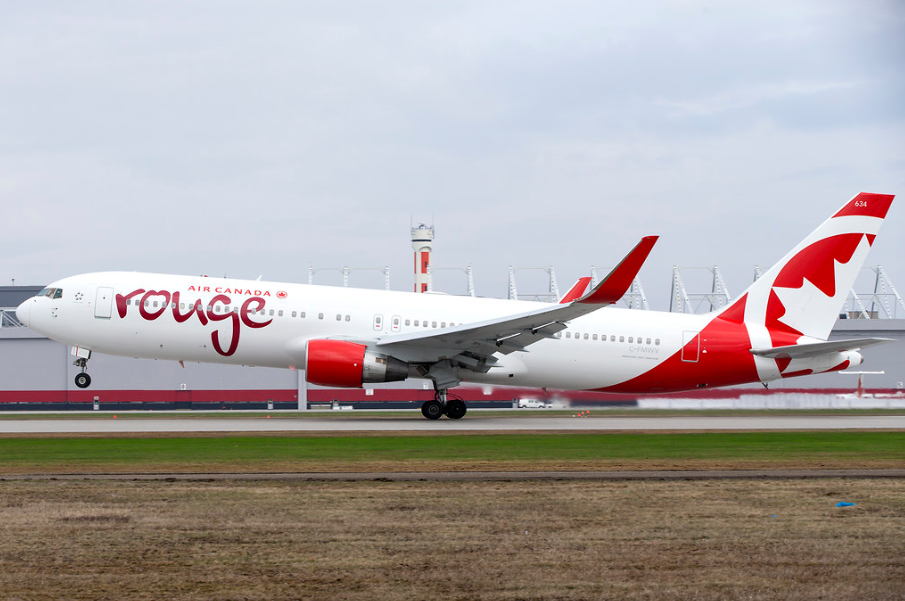Air Canada Brings Back Two Boeing 767-300ERs to Meet Growing Demand
At the beginning of the month, Air Canada announced during its quarterly financial results presentation that it will reincorporate two Boeing 767-300 (ER) aircraft, retired during the pandemic in 2020. The return of these passenger aircraft is due to delays in the delivery of Boeing 737 MAX aircraft caused by labor disruptions at the U.S. manufacturer.
The company continues to operate Boeing 767 aircraft in their cargo version, with six units. According to the Cirium platform, the two passenger 767s to be added carry the registrations C-FOCA and C-GLCA and spent four years at Marana-Pinal Airpark. In mid-2024, they were ferried to John C. Munro International Airport in Hamilton, Canada.
In Hamilton, the 35-year-old Boeing 767s have been observed undergoing thorough inspections and interior refurbishments. The company has not disclosed whether the aircraft will retain their old livery or be repainted with the current design.
First destinations for Air Canada’s 767s
In a new reservation system update, the first destinations for the passenger Boeing 767’s have been revealed. Operations will begin on February 1 and run until April 1, although this period may be extended if delays in the delivery of new aircraft persist.
The company will use these aircraft to operate flights to Phoenix (PHX), Las Vegas (LAS), Montego Bay (MBJ), Calgary (YYC), and Edmonton (YEG).
- Calgary: February 15 to April 30, initially three times a week, increasing to daily flights in April.
- Edmonton: February 15 to April 30, six weekly flights.
- Las Vegas: February 1 to March 29, one daily flight.
- Montego Bay: March 30 to April 30, one daily flight.
- Phoenix: Scheduled for April 14, 16, and 30.
The 767’s are temporarily replacing the Airbus A321. However, due to high-demand routes, the company uses a variety of aircraft, including the A220, Boeing 737 MAX, and even A330-300, Boeing 777-300 (ER), and Boeing 787 Dreamliners.
According to the company’s website, the pair of aircraft will maintain their 211-seat configuration, divided into 24 seats in business class and 184 in economy.
A brief history of the 767
The last passenger Boeing 767 operated by Air Canada was retired on June 2, 2020, at the height of the COVID-19 crisis, during an Air Canada Rouge flight between Montreal and Toronto.
However, Air Canada’s relationship with the 767 dates back four decades. In October 1982, it received its first 767 with registration C-GAUB. With the initial 767-200 and later the -200 (ER) model, the airline incorporated 23 units by 1996, replacing its fleet of Douglas DC-8 aircraft during the 1980s.
Air Canada was among the first North American airlines to use the 767 for transoceanic non-stop flights over the Atlantic. The 767 was the first aircraft to receive ETOPS certification for 120 minutes in 1985. The 767-200 operated until 2008 when it was replaced by A321ceo aircraft.

In 1994, Air Canada incorporated its first Boeing 767-300 (ER) aircraft, reaching six units by 1996. After its merger with Canadian Airlines, its main competitor, in 2021, the airline added more 767-300 (ER) aircraft, bringing its total to 32 aircraft.
In 2014, Air Canada began retiring its 767-300 (ER) aircraft, replacing them with 787 Dreamliners. The 767s were transferred to its leisure airline, Air Canada Rouge, founded in 2013, which operated 24 aircraft in 2017.
After 38 years as one of Air Canada’s main aircraft models, in June 2020, Air Canada retired its last 767 (C-GHOZ) and the last one operated by Air Canada Rouge, as a desperate measure to address the global crisis of 2020.

/https://aviacionlinecdn.eleco.com.ar/media/2022/01/air-canada-767.jpeg)
Para comentar, debés estar registradoPor favor, iniciá sesión